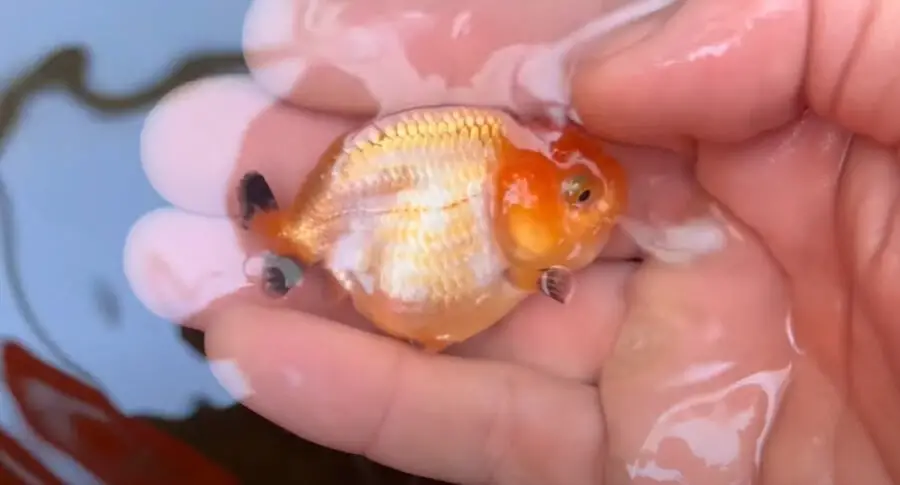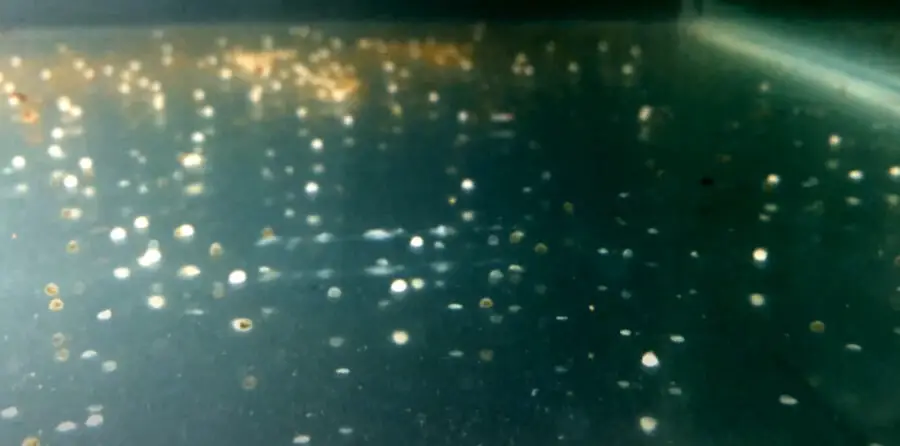Have you been looking at your goldfish and are wondering can a goldfish get fat?
Are they fat or are they bloated or pregnant? Do you need to do anything for them?
I will cover below how to identify why they are getting larger and what you need to do about it.
Can Goldfish Get Fat
Yes, goldfish can become overweight or “fat” if they are overfed or if their diet lacks proper nutrition. Overfeeding is a common cause of weight gain in goldfish. When they are consistently given excessive amounts of food, they may consume more than they need and their bodies store the excess as fat.
Goldfish have a natural tendency to eat whenever food is available, even if they are not hungry. It’s important to feed them in controlled portions and avoid overfeeding.
A good rule of thumb is to feed them an amount of food that they can consume within a few minutes and remove any uneaten food afterward.
Additionally, the type of food given to goldfish can also contribute to their weight and overall health.
Feeding them a balanced diet that includes a variety of high-quality pellets, flakes, and occasional treats like freeze-dried or fresh foods can help prevent excessive weight gain.
Are They Fat, Bloated or Pregnant
Below is a list of things you can check to identify why your goldfish is getting larger
Fat
Here are 10 signs that your goldfish may be overweight or obese:
- Bulging or rounded body shape: The goldfish’s body appears plump or round rather than streamlined.
- Large or protruding belly: The abdomen is visibly distended, often giving the goldfish a “potbelly” appearance.
- Difficulty swimming or staying upright: Excess weight can impair their buoyancy and cause them to struggle while swimming or maintain a balanced position.
- Reduced activity level: Overweight goldfish may become lethargic and less active compared to their healthier counterparts.
- Labored breathing: Obesity can put strain on the goldfish’s respiratory system, leading to increased breathing difficulties.
- Bottom-sitting behavior: Overweight goldfish may spend more time resting or sitting on the bottom of the tank, showing less interest in swimming.
- Fins clamped close to the body: The fins may appear pressed tightly against the goldfish’s body instead of being held open and erect.
- Difficulty or reluctance to eat: Obesity can impact their appetite, causing them to eat less or lose interest in food.
- Scale protrusion: The scales on an overweight goldfish may start to separate or become raised, creating a “pinecone” or bloated appearance.
- Reduced lifespan and overall health: Obesity in goldfish can lead to various health issues and shorten their lifespan compared to healthy, well-maintained fish.
Below is a picture of one of my fat goldfish

Bloated
Here are 10 signs that your goldfish may be bloated:
- Swollen or distended abdomen: The goldfish’s belly appears larger or swollen compared to its usual size.
- Bulging or rounded body shape: The overall body shape looks plump or rounded, especially in the abdominal area.
- Loss of body contours: The natural contours and shape of the goldfish’s body may become less defined due to bloating.
- Scales sticking out or raised: The scales might appear to be sticking out or raised, giving the goldfish a “pinecone” or bloated appearance.
- Difficulty swimming or staying upright: Bloating can affect the goldfish’s buoyancy, causing it to struggle or have difficulty maintaining a balanced position in the water.
- Lethargy or reduced activity: Bloated goldfish may become less active and spend more time resting or hovering near the bottom of the tank.
- Decreased appetite: Bloating can result in a decreased interest in food, leading to reduced or reluctant eating.
- Stringy or discolored feces: Bloating may be accompanied by abnormal feces, such as long, stringy, or discolored droppings.
- Loss of appetite and weight loss: Severe bloating can cause a loss of appetite and subsequent weight loss in the affected goldfish.
- General signs of discomfort or distress: The goldfish may exhibit signs of discomfort, such as rubbing against objects, increased breathing rate, or flashing (quickly darting around the tank).
Pregnant
Goldfish do not get pregnant in the same way that mammals do. They are egg-laying fish, and the term “pregnant” is not used to describe their reproductive process. However, there are certain signs that can indicate that a goldfish is ready to lay eggs. Here are 10 signs to look out for:
- Distended abdomen: The female goldfish’s abdomen may appear swollen or larger than usual.
- Wider body shape: The female goldfish may have a broader and rounder body shape overall.
- Pink or reddish vent: The vent, which is the genital opening located near the anal fin, may appear swollen or slightly reddish in color.
- Restlessness and increased activity: The female goldfish may exhibit increased swimming activity and restlessness, often searching for suitable spawning sites.
- Chasing behavior: Male goldfish may exhibit chasing behavior, relentlessly pursuing the female.
- Rubbing against objects: The female goldfish may rub her abdomen against plants or tank decorations, a behavior known as “shimmying,” to stimulate egg release.
- Ovipositor visible: In some cases, the female goldfish’s ovipositor (a small tube near the vent) may become slightly protruded.
- Changes in eating behavior: The female goldfish may show a reduced appetite or may stop eating altogether as she focuses on preparing for egg laying.
- Increased size and number of eggs: As the spawning season approaches, the female goldfish’s ovaries may become larger and more prominent.
- Mating behavior: The male goldfish may exhibit breeding behaviors such as nudging the female’s abdomen, chasing, or nudging her sides.
Below is a picture of one of my pregnant goldfish eggs

Treatments
What to Do if Your Goldfish Is Fat
Here are several steps you can take to help address the issue and promote its health:
- Adjust the feeding regimen: Ensure you are providing your goldfish with an appropriate and balanced diet. Feed them a variety of high-quality pellets, flakes, and occasional treats, while controlling the portion sizes. Avoid overfeeding and only offer an amount of food that they can consume within a few minutes.
- Limit the frequency of feedings: Instead of continuously offering food throughout the day, establish a regular feeding schedule with two to three small meals per day. This allows the goldfish to have a chance to digest the food properly between feedings.
- Monitor portion sizes: Be mindful of the amount of food you are providing during each feeding. It’s better to slightly underfeed than to overfeed. You can adjust the portion sizes based on the goldfish’s body size and activity level.
- Consider alternative feeding methods: Rather than using floating food that the goldfish can easily consume, consider sinking pellets or pellets that require more effort to eat. This can help slow down their feeding and prevent excessive consumption.
- Increase exercise opportunities: Encourage physical activity in your goldfish by providing a larger tank or pond with ample swimming space. Adding aquarium decorations and plants can create an engaging environment that promotes movement and exploration.
- Avoid feeding inappropriate or low-quality foods: Ensure that the food you are offering is suitable for goldfish and provides proper nutrition. Avoid giving them foods that are high in fat or low in nutrients, as this can contribute to weight gain without providing the necessary nutrients for their well-being.
- Maintain good water quality: Proper water quality is crucial for the overall health of goldfish. Ensure regular water changes, proper filtration, and monitoring of water parameters to prevent stress and maintain optimal health.
What to Do if Your Goldfish Is Bloated
If you observe that your goldfish is bloated, it’s important to address the underlying cause and take appropriate action. Here are some steps you can take if your goldfish is bloated:
- Assess water quality: Check the water parameters of the tank, including ammonia, nitrite, nitrate levels, and pH. Poor water quality can contribute to digestive issues and bloating. Perform a partial water change if necessary to improve water conditions.
- Review feeding habits: Evaluate your goldfish’s feeding regimen and ensure you are not overfeeding. Adjust the portion sizes and feeding frequency to prevent excessive consumption.
- Consider fasting: Temporarily withhold food for a day or two to allow the goldfish’s digestive system to rest and potentially resolve any bloating caused by overeating or digestive issues. Monitor the fish during the fasting period and resume feeding only if it appears healthy and active.
- Offer a high-fiber diet: Introduce fiber-rich foods such as blanched peas (with the skins removed) into the goldfish’s diet. Peas can help alleviate constipation and aid in digestion. Feed peas sparingly as a treat, not as a regular staple.
- Increase water temperature: Slightly raising the water temperature by a few degrees (up to 78-80°F or 25-27°C) can stimulate digestion and help relieve bloating. Ensure gradual temperature changes to avoid stressing the goldfish.
- Maintain good water circulation: Adequate water movement and circulation in the tank can aid in digestion. Ensure the water filtration system is functioning properly and provides sufficient water flow.
What to Do if Your Goldfish Is Pregnant
When your goldfish is ready to lay eggs, here are some steps you can take to support the spawning process:
- Provide appropriate breeding conditions: Set up a separate breeding tank or provide suitable spawning materials, such as spawning mops or fine-leaved plants, where the goldfish can lay their eggs. These materials can provide a safe space for the eggs to be deposited and protected.
- Monitor water quality: Ensure the water parameters in the breeding tank are optimal. Maintain good water quality by performing regular water changes and monitoring parameters such as ammonia, nitrite, nitrate levels, and pH.
- Observe and monitor behavior: Watch for spawning behavior, such as the male chasing the female, nudging or bumping the female’s abdomen, and the female showing interest in the spawning materials. This indicates that the goldfish is preparing to lay eggs.
- Allow for privacy and minimize disturbances: Provide a calm and quiet environment for the goldfish during the spawning process. Minimize disturbances and avoid sudden movements or loud noises around the tank to prevent stress and potential disruption of the breeding behavior.
- Separate the eggs: Once the goldfish has laid their eggs, you may choose to remove the eggs from the breeding tank to a separate rearing tank to protect them from being eaten by the adult goldfish. Use a gentle method, such as carefully transferring the eggs onto a mesh or using a dedicated egg collection device.
Frequently Asked Questions
What Does a Bloated Goldfish Look Like?
A bloated goldfish appears swollen or distended, particularly in the abdominal area. Its body may take on a rounded or bulging shape, and the scales might protrude or appear raised. The fish may exhibit difficulty swimming, reduced activity, and potential signs of discomfort.
What Does an Overfed Goldfish Look Like?
An overfed goldfish may have a visibly rounded or swollen belly, giving it a “potbelly” appearance. Its body shape may appear plump or bulky, and the fish might have difficulty swimming or maintaining balance. Overfeeding can lead to excessive weight gain and potentially health issues.
How Long Do Chubby Goldfish Live?
The lifespan of a goldfish can vary depending on various factors, including genetics, care, and overall health. While there isn’t a specific lifespan for “chubby” goldfish, it’s important to note that obesity can lead to health problems and potentially shorten the fish’s lifespan. With proper care, a well-maintained goldfish can live for 10 to 20 years or even longer in some cases.
Table of Contents
